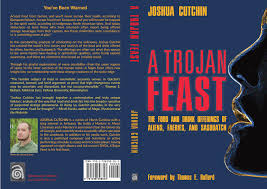Review: A Trojan Feast November 19, 2015
Author: Beach Combing | in : Contemporary, Modern , trackbackNow here’s an easy question on mythology. Tomorrow at noon you will be taken off to the infernal regions by an underworld spirit. You have twenty four hours to prep from the seventy or eighty volumes of mythology on your shelves. What one lesson do you bring away from your reading before you are taken below? It’s simple, bozo, don’t eat. You can pinch the spectral serving girls’ bottoms, you can try and steal some of the cutlery, you can take selfies with Pluto, you can write graffiti on the grey oaken tables… But whatever happens and whatever anyone does, DO NOT put otherworldly food or drink in your mouth. If you do you won’t be coming back… This is 101 Folklore. But there has not been a serious study of the question of eating otherworldly food: perhaps the best we had is a very good chapter by Edward Sydney Hartland from 1891. Or rather there was no serious study until the publication of A Trojan Feast: The Food and Drink Offerings of Aliens, Faeries and Sasquatch.
Beach came to this volume with an interest in fairies, and looked a little askew at the inclusion of off-planeters and wild men. But Passport to Magonia begins, after all, with a passage comparing an alien giving food to an abductee to a fairy giving food to a mortal and JC makes the case (convincingly) that all the injections, creams and lotions lavished on abductees needs to be classed with fairy pancakes and fairy wine. Sasquatch is a harder sell,* but it is clear that, in the same way some individuals have included UFOs in their personal path to Nirvana, Big Foot is now signed up to the New Age. It is certainly striking, reading Trojan Food, how many abduction stories exist where a young man or woman claims to have been carried off by the Yeti or one of his many cousins.
So we have a series of, let’s call them, ‘entities’ (hairy, winged or out of this world) and we have human beings who encounter these entities through insanity, drugs or just out while picking blackberries. We then have food and drink that passes between them. What should we make of this? Well, this is an impossible question and, while moving towards an answer of sorts, JC spends most of the book doing the only intelligent thing possible: he circles around the problem like a weasel around a very big chicken. Intimidating the data into once place and telling it to stop squawking is actually a major achievement. The evidence after all comes from five continents: entities and food are part of that select list with sex, gender, sales tax and childhood that unite the whole species.
What Beach got out of this most stimulating book is that food is, to use one of Josh’s chapter titles, all about ‘giving and taking’. Humans give food to entities, entities give food to humans: sometimes giving food does good, sometimes it damages the relationship. (Memories of fairy-human symmetry). In fact, to use a word that JC avoided food seems to be a kind of ‘contract’ between humanity and our shadows. By eating we join a new community: at that point the food can imprison us or tastes better than anything we’ve ever ingested. By giving (or allowing the little bastards to steal) we supplicate the entity: the entity likewise feels bound or it feels embraced.
Fascinating stuff: wonder what Josh’s next project is.
Beach is always on the look out for interesting books, particularly if there are fairies: drbeachcombing AT yahoo DOT com
*Since writing this in July and re-reading it now I’ve come around completely (having been inspired to read more): Josh was absolutely right to include Sasquatch.



